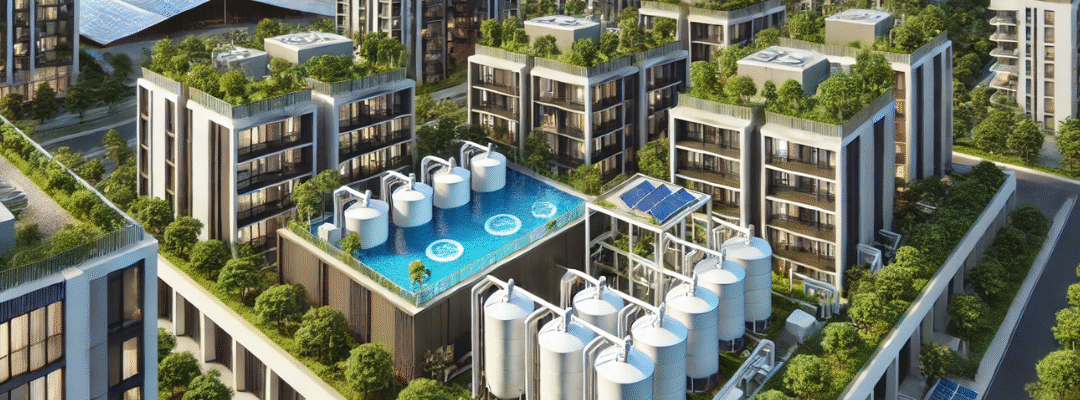Making apartment buildings sustainable through water management involves ensuring that the building can effectively store and manage enough water to meet the needs of residents while reducing dependence on external water supplies and minimizing waste. This can be achieved through efficient water storage, rainwater harvesting, greywater recycling, and efficient water use. Here’s how large water tanks and smart water management can contribute to the sustainability of apartment buildings:
Key Considerations for Sustainable Water Management in Apartment Buildings
Water Demand Calculation
Occupancy: First, determine the number of residents and their average daily water consumption. Typically, an individual in an apartment uses between 100-150 liters (26-40 gallons) of water per day, depending on the water efficiency of appliances and fixtures.
Example: A building with 50 apartments, each with 4 occupants, would require about 20,000-30,000 liters (5,280-7,920 gallons) per day.
Rainwater Harvesting
Catchment Area: Estimate the catchment area (typically the roof) and the amount of rainwater that can be collected annually based on local rainfall. The formula for calculating potential water from rainwater harvesting is: Harvested Water (liters)=Catchment Area (sq meters)×Annual Rainfall (mm)×Runoff Coefficient (0.8-0.9)\text{Harvested Water (liters)} = \text{Catchment Area (sq meters)} \times \text{Annual Rainfall (mm)} \times \text{Runoff Coefficient (0.8-0.9)}Harvested Water (liters)=Catchment Area (sq meters)×Annual Rainfall (mm)×Runoff Coefficient (0.8-0.9)
Storage Capacity: Depending on the amount of rainwater collected and the building’s demand, a large rainwater storage tank can significantly reduce reliance on municipal water.
Supplementing Domestic Water: Rainwater can be used for non-potable purposes such as flushing toilets, washing cars, landscaping, and laundry, potentially covering 40-50% of the building’s water needs.
Greywater Recycling
Greywater Sources: Water from showers, sinks, washing machines, and bathtubs can be collected and treated for reuse in flushing toilets, landscaping, or cooling systems.
Storage and Treatment: A greywater recycling system would require storage tanks to hold treated greywater. This can offset about 30-50% of water demand.
Tank Capacity for Greywater: Depending on the size of the apartment building, greywater systems can store anywhere from 10,000 to 20,000 liters (2,640 to 5,280 gallons) to meet non-potable water demands.
Water Storage for Emergencies
Emergency Reserves: Sustainable apartment buildings should be equipped to store water for emergency situations such as water supply disruptions. Storing enough water to last for 3-7 days for all residents ensures resilience.
For example, a building with 200 residents and average daily use of 100 liters per person would need 60,000 to 140,000 liters (15,850 to 36,980 gallons) for 3-7 days of emergency supply.
Peak Water Storage Requirements
Daily and Peak Demand: In high-demand periods, water storage tanks need to accommodate peak usage, such as early mornings and evenings when water consumption tends to spike.
Sizing Tanks for Peak Use: Typically, a buffer of 25-30% more than daily usage is recommended to cover these peaks. For the 50-apartment example mentioned above, peak demand would require an additional 5,000-8,000 liters (1,320-2,110 gallons).
Sustainable Water Solutions for Apartment Buildings
Rainwater Harvesting Tanks
Sustainable Impact: Rainwater harvesting tanks can be large, often ranging from 20,000 to 50,000 liters (5,280 to 13,200 gallons) or more for apartment buildings. These tanks can store collected rainwater to be used for non-potable purposes.
Reduction in Municipal Water Dependence: A well-sized rainwater harvesting system can reduce the building’s dependence on municipal water by 30-40%, especially in regions with high rainfall.
Greywater Recycling Systems
Storage and Reuse: Greywater recycling systems typically need storage tanks of 10,000-30,000 liters (2,640 to 7,920 gallons) for large apartment buildings, depending on the level of water reuse.
Water Savings: Greywater recycling can cut water demand by up to 30-50% in an apartment building by reusing water for toilets, irrigation, and other non-potable uses.
Combined Systems for Maximum Sustainability
Integrated System: Combining rainwater harvesting and greywater recycling with efficient water storage tanks can reduce water consumption by up to 60-70%.
Storage Capacity: For example, a combined rainwater and greywater system might need total storage of 50,000-100,000 liters (13,200-26,400 gallons) to supply enough water for large residential complexes with over 100 apartments.
Summary: Optimal Water Tank Sizing for Sustainability
| Factor | Suggested Storage (Liters) |
|---|---|
| Daily Use (100–150 L/person) | 20,000–30,000 for 200 residents |
| Rainwater Harvesting | 20,000–50,000 |
| Greywater Storage | 10,000–30,000 |
| Emergency Reserve (3–7 days) | 60,000–140,000 |
| Peak Demand Buffer | 5,000–10,000 extra |
Conclusion
For apartment buildings to be sustainable, incorporating rainwater harvesting, greywater recycling, and large-capacity water storage tanks is essential. A building’s total water storage capacity should be tailored to daily consumption, peak demand, and emergency needs, generally falling between 50,000 to 100,000 liters for medium to large buildings. By implementing these systems, apartment buildings can reduce reliance on external water sources, lower utility costs, and promote environmental sustainability.

